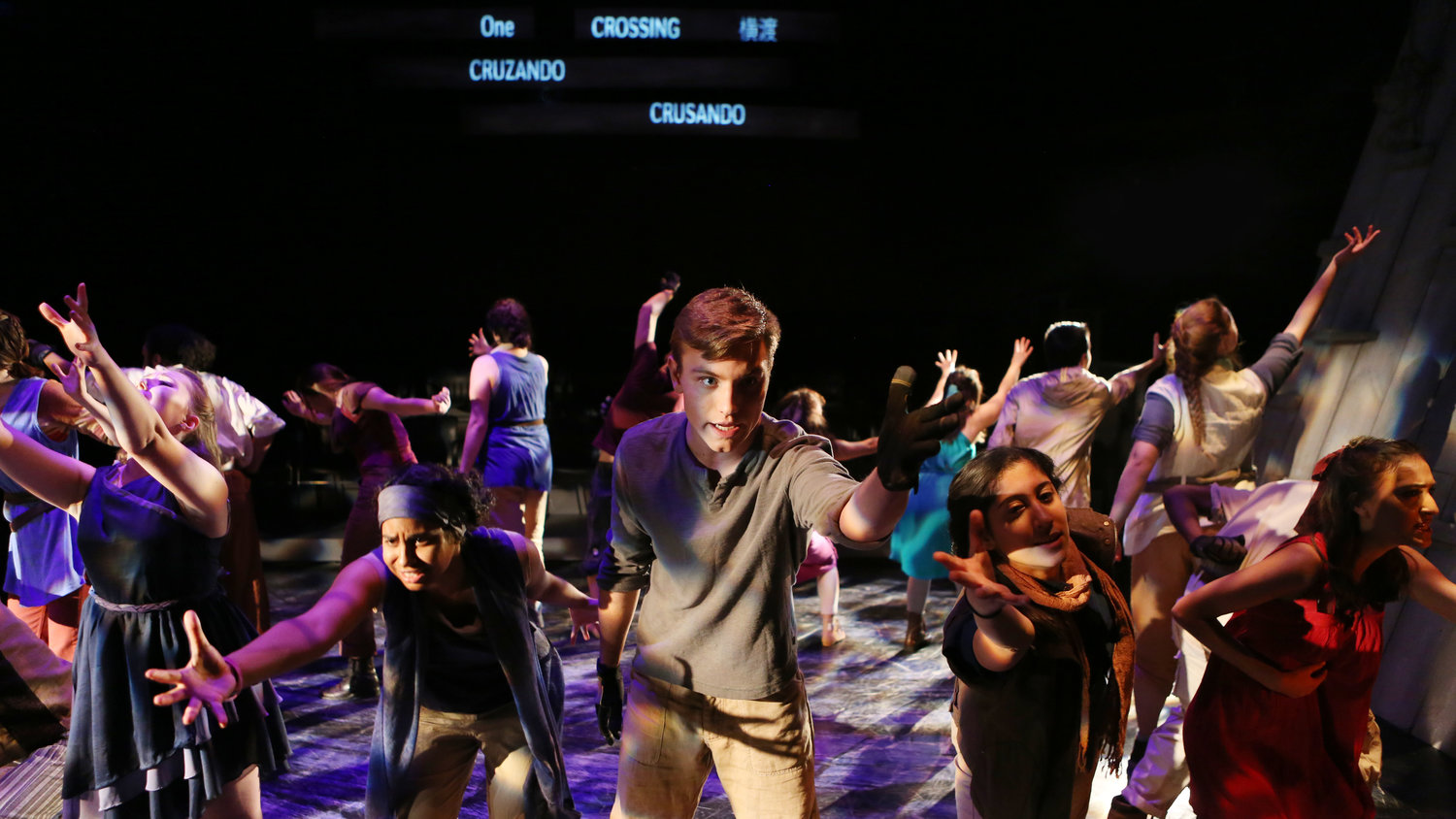
From left: Izabella Rinskaya ’19 (Penelope Chorus), Jamin Garcia ’20 (Chorus of the City), Ted Randell ’19 (Odysseus Chorus), Dana Tohme ’20 (Chorus of the City), and Daniella Deutsch ’17 (Penelope Chorus). Photo: Sue Kessler
ON RADICAL THEATER
By Caity Cook ’18
“Here. On this earth.”
Beginning with these short, simple words, Caridad Svich’s poetic dance-theater piece The Orphan Sea asks us to stop for a moment and exist in solely the present. In this first moment, and then at several points throughout the production, actors pause on stage and look towards the audience, carefully making eye contact with each of us and speaking directly for our ears. “Look at each other,” they say as a chorus, prompting us to look past them and see the audience members sitting directly across from us on the other side of the stage. “Let us talk with each other.”
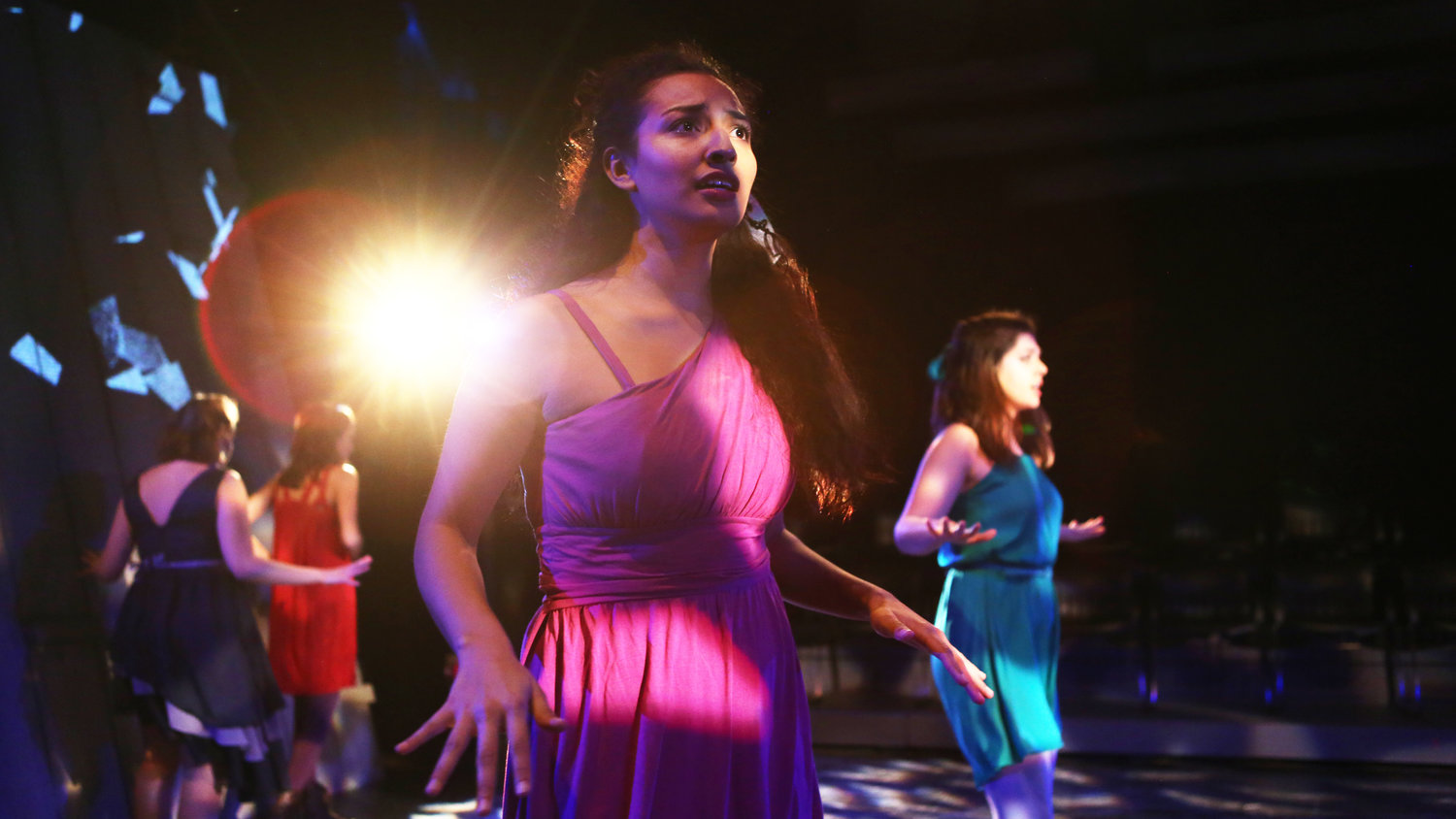
Julianna Quiroz ’17 (Penelope Chorus). Photo: Sue Kessler
This desire to spark a conversation is one of the most powerful aspects of The Orphan Sea, which uses the characters of Homer’s epic poem The Odyssey to tell a timeless story of migrants and the displaced. Before the start of the semester, director Eunice Ferreira made a strategic choice to stage this production close to the presidential election. She knew that she would work with her cast members to translate pieces of the text, creating a multilingual piece that would make profound statements on the status of immigrants, refugees, and outsiders in the United States and across the world today. This decision was well-founded: reverberations of a volatile political climate are the pulsing undercurrent that propels this play’s action forward, imbuing each word and movement with tremendous weight and power.
Svich’s script takes the classic story of Penelope and Odysseus—the story of “those who cross and those who wait”—and retells it within a space that is timeless in that it is inclusive of all time and all place. Each of the lovers is played not by a single actor but by an entire chorus, each member of which speaks several languages throughout the show. The Penelope Chorus (Molly Burdick ‘17, Daniella Deutch ‘17, Izabella Rinskaya ‘19, and Julianna Quiroz ‘17) wait for their far-away lovers, longing for their closeness and touch. Each woman is an individual, but together they embody a universal idea: the bond that can form between women through isolation and despair. Likewise, each member of the Odysseus Chorus (David Gympo ‘19, Grant Landau-Williams ‘19, Chris Naughton ‘17, and Ted Randell ‘19) has his own identity, each a facet of the whole: there’s the traveller, the soldier, the philosopher, the lover. We see their struggle as they traverse the country, each bound always to return to his Penelope.
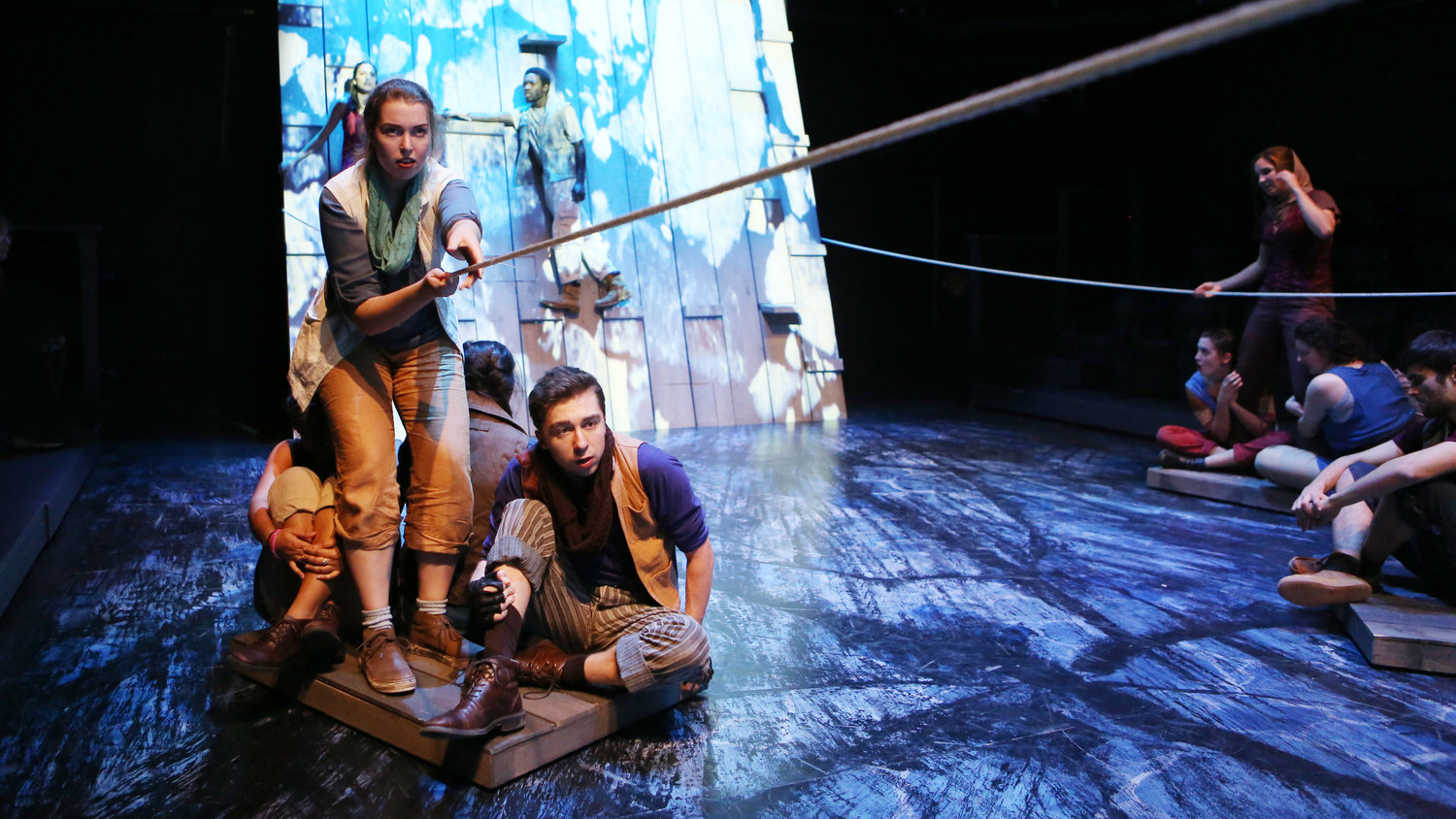
Sam Grant ’18 (Chorus of the City) and Graham Cook ’19 (Chorus of the City). Photo: Sue Kessler
A third chorus, the Chorus of the City (Maria Carrera ‘20, Graham Cook ‘19, Junxi “Marco” Gao ‘20, Jamin Garcia ‘20, Rebecca Gracey ‘18, Sam Grant ‘18, Dana Tohme ‘20, Annabelle Vaës ‘19, and Brandon Young ‘20) is woven into the action as well. These actors sometimes operate as fellow audience members, teaching us through their movements how to interact with the actors on stage, and sometimes as the lovers’ city itself, creating the atmosphere through their words and bodies. Initially, each chorus acts as its own independent entity; eventually, all three blend together, moving and speaking as one.
As Penelope and Odysseus long for one another from opposite sides of the sea, they cross rivers, wander dusty roads, and climb high walls to get back to one another. The two walls, the hallmarks of designer Jared Klein’s set, stand tall on either side of the playing space, looming over us with the ominousness of a very real political threat. But the lovers’ co-opting of this wall—climbing over it, lounging on it, and, once they’re reunited, transforming it into their marriage bed–responds to this threat with one of their own: love will not be kept apart.
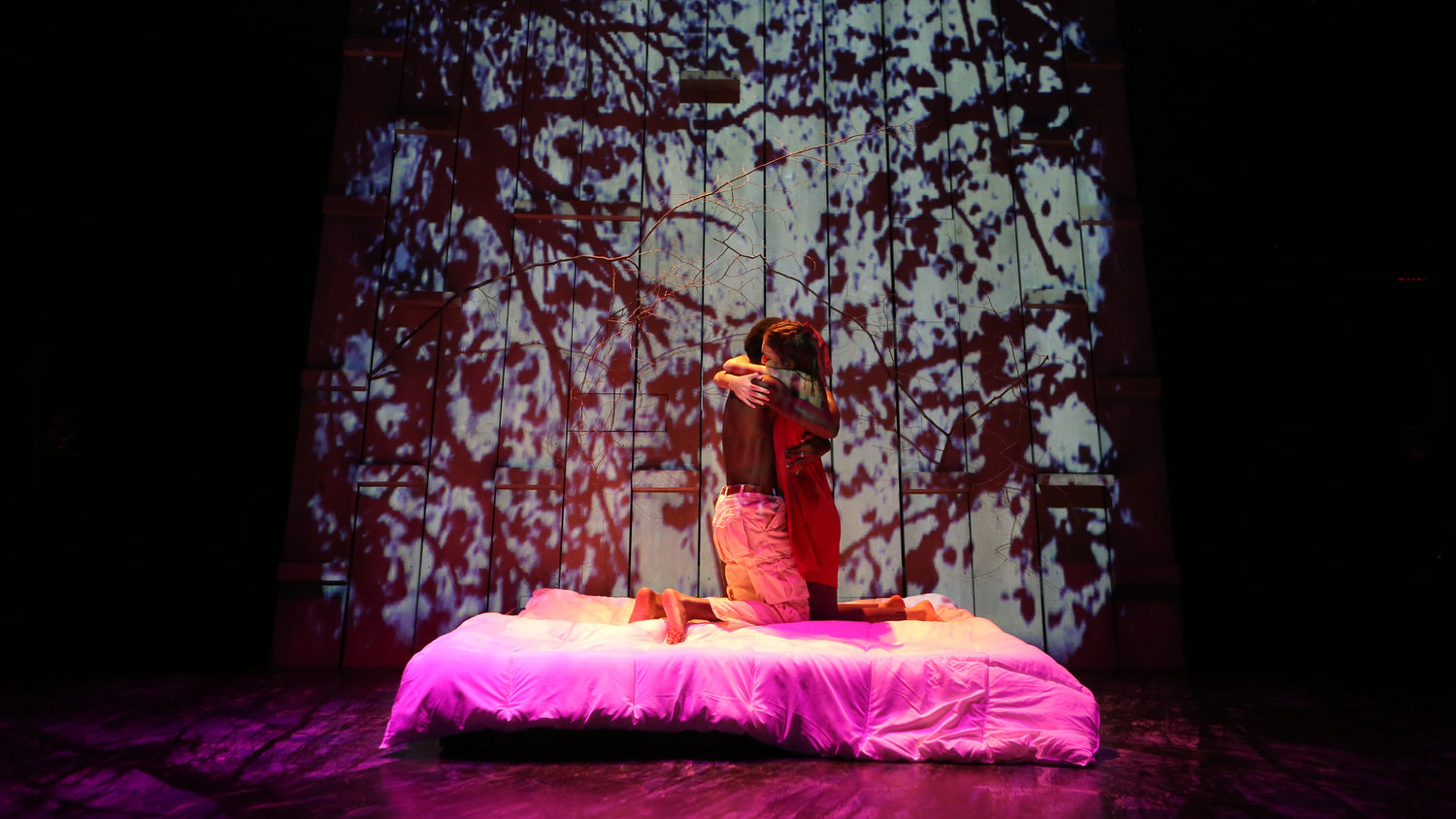
David Gympo ’19 (Odysseus Chorus) and Daniella Deutsch ’17 (Penelope Chorus). Photo: Sue Kessler
A series of projections, designed by Klein along with Giorgos Petkakis ‘18, further transform this space—which could have been dominated by fear and sorrow—into a beautiful environment, one that evokes the beauty of the empty, starry landscapes the lovers roam. They also demonstrate the more abstract themes of the show: the role that video and media play in shaping our socio-political landscape, the ancient thread of storytelling, and the metatheatrical nature of the show. The lighting design (Chloe Brush ‘18) fulfills a similar role; it alternates between warm highlighting of the actors’ bodies and stark accentuation of our real-time position.
Each movement piece, devised initially by the cast and then further choreographed by Skidmore Dance Department faculty member Erika Pujič, creates a sense of unity throughout the multilingual cast. The movement pieces act as an additional language, one that is as universal as the love between Penelope and Odysseus. During the lovers’ separation, the movements are longing, reaching. Once the two are reunited, they become more sensual, more bodily. The slight variations in each character’s movements expose the humanity that exists beneath these traditional personas.
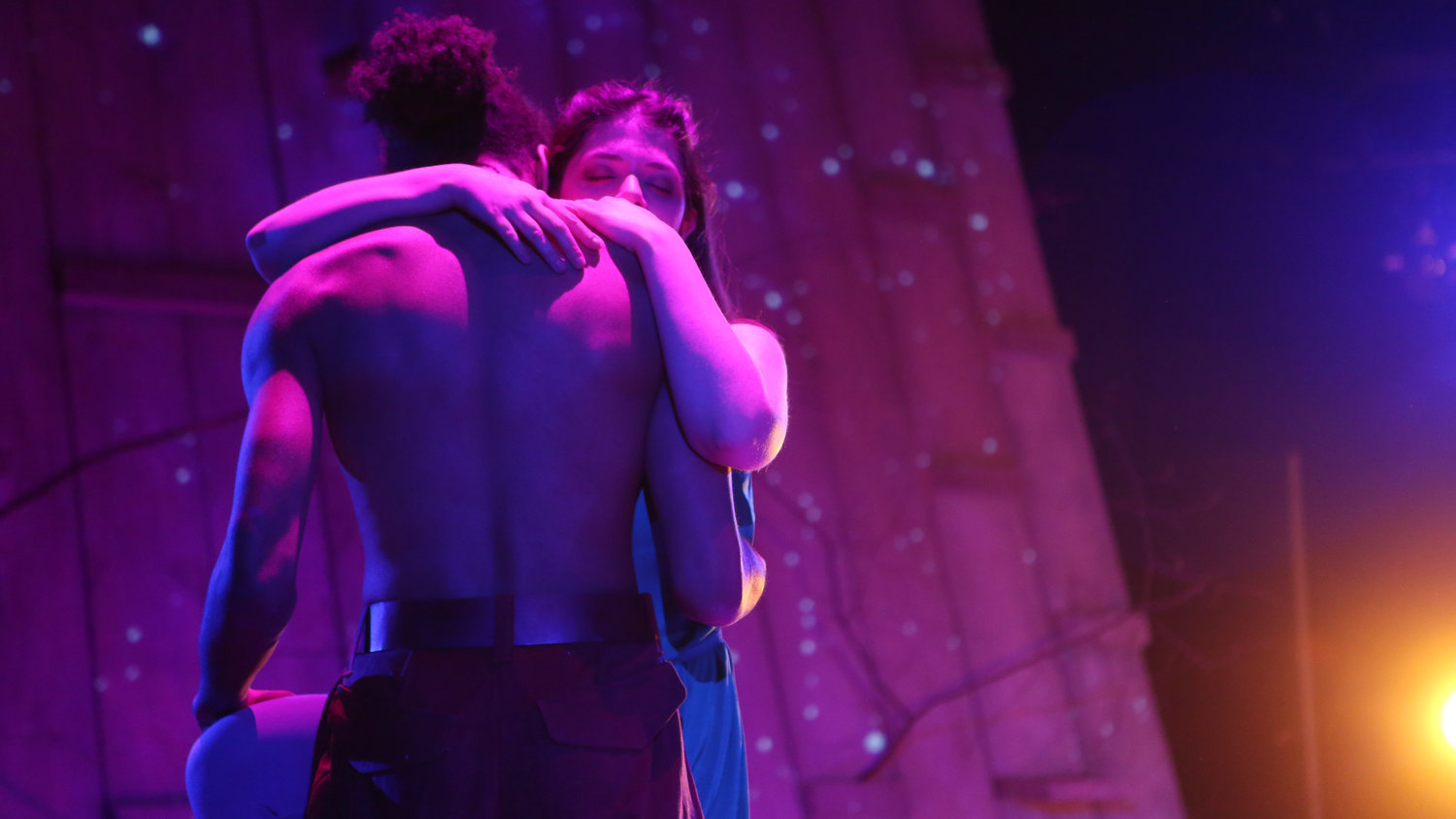
Grant Landau-Williams ’19 (Odysseus Chorus) and Molly Burdick ’17 (Penelope Chorus). Photo: Sue Kessler
And the music of this show speaks as a character of its own—a fourth chorus. Musical director Izzy Howard ‘17 sets text to music, evoking an ancient tradition of ballads and troubadours. Then she scores the show with music that forms a sometimes smooth, sometimes dissonant backdrop for the action, with songs that run the gamut from hip-hop to jazz to Justin Timberlake.
This production, the text and design remind us, does not exist in a vacuum. We are part of a large, complicated world, and we do not leave it behind when we enter the theater. The events of this production take place here: on this earth, in this room. They are real, and they have real ramifications. When the actors bid us to look to each other, to speak to each other, they—and we—are partaking in a radical action. Theater’s tremendous capacity to unite people from various backgrounds cannot be overstated. The chance to physically come together—in real life, not through a screen, not mediated by layers of spin and unreality—means that we can learn to listen, to see, to empathize. We hear the stories of our neighbors, of those like and unlike us, of those whose stories are often forgotten. We give voice to the voiceless and an audience to the unheard. We recognize our shared humanity. Make no mistake, theater like The Orphan Sea is not a distraction from politics or the fight for social justice; rather, it is an invitation to participate in it, through radical love, radical resistance, and radical storytelling. It is exactly what we need, here and now.
***
Caity Cook ’18 is a junior English major and Theater minor. She is Editor-in-Chief of the Skidmore Theater Living Newsletter.
PRODUCTION PHOTOS
REFLECTIONS FROM THE CAST AND CREW
Molly Burdick ‘17 (Penelope Chorus): This group of people was incredibly open and willing to try anything, which made the rehearsal room a very safe space for experimentation. I loved it especially because so many people in the cast were new to the department and I got to know and love so many people I may not have met otherwise.
Giorgos Petkakis ’18 (Co-Projection Designer): Co-designing with Jared was an invaluable learning experience. Collaborating on finding a uniform design direction helped me align the video to the piece, as opposed to my artistic style alone.
Dana Tohme ‘20 (Chorus of the City): It was really interesting to work with people who come from different parts of the world, with diverse traditions and languages. I think this is what made us so close—we were all interested in getting to know about others’ culture and learning new languages. We are all so different but somehow we fused perfectly.
Dante Haughton ‘19 (Assistant Projection Designer): I reached out to Jared, a few weeks after cast and crew roles were chosen, to see if there was any room for me to contribute to the multimedia-heavy production that so explicitly sought to be multicultural. I was surprised by how welcoming The Orphan Sea team was to me when I joined late; what was special about this team was its circulated love, openness, and patience that led to effective collaboration.
Production Credits
Written by: Caridad Svich
Director: Eunice S. Ferrreira
Assistant Director: Michael San Roman ‘17
Stage Manager: Ariella Hakim ‘17
Scenic Designer: Jared Klein
Projection Designer: Jared Klein and Giorgos Petkakis ‘18
Lighting Designer: Chloe Brush ‘18
Choreographer: Erika Pujič
Costume Designer: Patty Pawliczak
Musical Director: Izzy Howard ‘17
Hair + Makeup Designer: Laura McCullagh ‘17
Cast: David Gyampo ‘19 (Odysseus Chorus), Grant Landau-Williams ‘19 (Odysseus Chorus), Chris Naughton ‘17 (Odysseus Chorus), Ted Randell ‘19 (Odysseus Chorus), Molly Burdick ‘17 (Penelope Chorus), Daniella Deutsch ‘17 (Penelope Chorus), Julianna Quiroz ‘17 (Penelope Chorus), Izabella Rinskaya ‘19 (Penelope Chorus), Maria Carrera ‘20 (Chorus of the City), Graham Cook ‘19 (Chorus of the City), Junxi “Marco” Gao ‘20 (Chorus of the City), Jamin Garcia ‘20 (Chorus of the City), Rebecca Gracey ‘18 (Chorus of the City), Sam Grant ‘18 (Chorus of the City), Dana Tohme ‘20 (Chorus of the City), Annabelle Vaës ‘19 (Chorus of the City), B randon Young ‘20 (Chorus of the City)
Crew: James Varkala (Assistant Technical Director), Chris Monaco ‘18 (Assistant Stage Manager), Hannah Olinger ‘17 (Assistant Stage Manager), Romi Moors ‘18 (Assistant Scenic Designer and Props Master), Max Helburn ‘18 (Associate Sound Designer and Master Electrician), Amanda Corey ‘17 (Assistant Costume Designer), Dante Haughton ‘19 (Assistant Projection Designer), Francesca Parker ‘17 (Dramaturg), Sarah Markley ‘19 (Scenic Charge Artist), Jessie Blackman ‘20 (Light Board Operator), August Sylvester ‘20 (Sound + Projections Operator)
Related Articles
Embracing and Structuring the Abstract: The Design Team Behind The Orphan Sea
A Conversation with The Orphan Sea Director Eunice S. Ferreira
JKB Life: The Orphan Sea





























